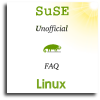-
Open the YaST Sysconfig Editor. ->-> /etc/sysconfig. Select ->->
-
Insert the modules cdrom and
ide-cd after the
root=/dev/hdaX listing. Be careful not to remove
any of the modules listed, since they are necessary for booting.
-
Edit the /boot/grub/menu.lst file, making the
following additions in this order:
max_scsi_luns=1 hdb=ide-scsi hdc=ide-scsi
(in the linux kernel line, after the root=/dev/hdaX entry).
-
Now, execute the mk_initrd command as root. To do
this open a terminal program like konsole or xterm and log in as root
with the command su -. Then enter the command
mk_initrd. If your boot manager is LILO, reinstall
it with the command lilo -v. As GRUB is the standard
boot loader from SuSE Linux 8.1 on, this will not apply for most. This
will allow all devices to be emulated as SCSI.
-
Reboot the system for changes to take effect.
-
Now determine the SCSI device numbers assigned to your physical IDE
devices using the cdrecord -scanbus command. The
command output will give you the numbers needed to link your newly
emulated SCSI devices.
EXAMPLE: If there is a 0) before your
DVD device, then your DVD device should be linked to SCSI device 0.
Hence, the command you would use is ln -sf /dev/sr0
/dev/dvd. If it was your CD-ROM instead of your DVD-ROM you
would use ln -sf /dev/sr0 /dev/cdrom.
If your CD writer follows after a 1), then the command will be
ln -sf /dev/sr1 /dev/cdrecorder. The combination of
sr0 and sr1 and the devices cdrom, dvd and cdrecorder depends on the
numbers listed in the line from the cdrecord
-scanbus output.
-
Using the information obtained from the cdrecord
-scanbus command (see Step 3), point all
devices (dvd, cdrecorder and cdrom) to their respective scsi
device.
Example: ln -sf /dev/sr0
/dev/dvd links the dvd to the scsi device sr0.
-
Type hwscan --list as root. Note all keys for each
CD device. There will likely be multiple entries for any given CD
device. Delete each of the noted CD device entries in the /var/lib/hardware/unique-keys directory.
Note
Deleting the unique-key CD device entries can easily be done in
Konqueror as root. To do so, log in as root, follow the
hwscan --list portion of this step from a konsole
session.
Then open Konqueror, delete any of the unique-key files associated
with a CD device, (right click and
delete).
-
Open a konsole session and type the hwscan --cdrom
command to populate the newly added (and correct) unique-key CD device
entries.
-
Reboot your system and you should have two working devices with no
errors at boot up.


